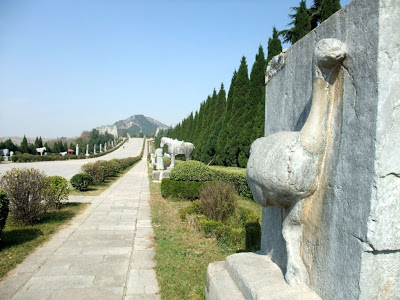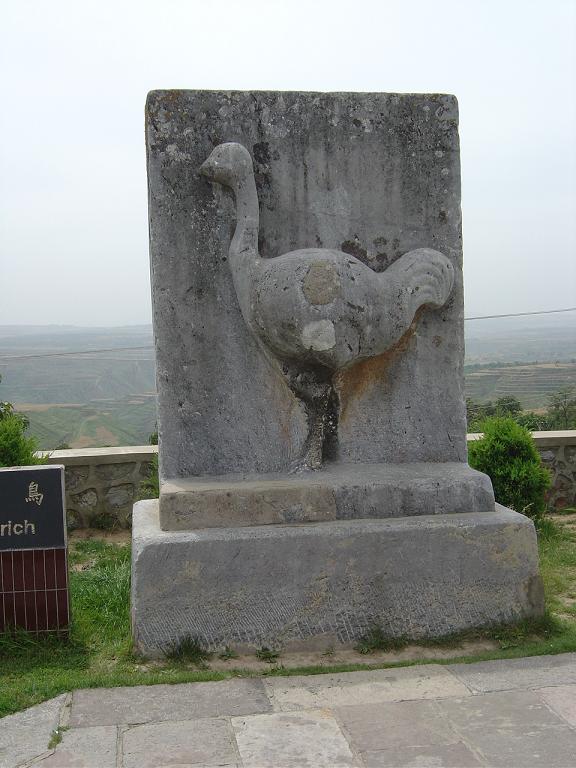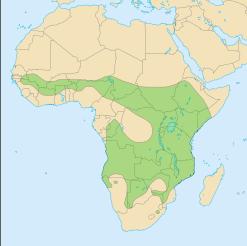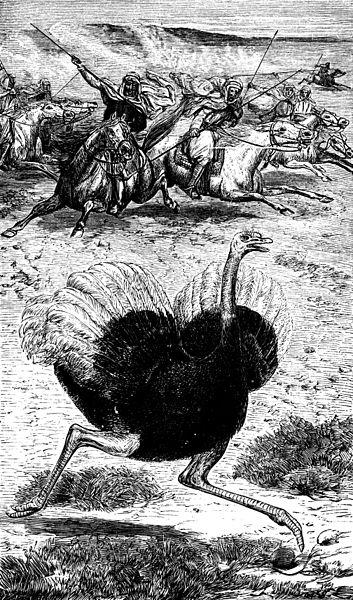Ostrich in Medieval China November 19, 2017
Author: Beach Combing | in : Medieval , trackbackChinese Ostriches
The Qianling Mausoleum was used for three hundred years (from the seventh to the very early tenth century) by Tang dynasty emperors and their court officials. It includes, in some of its magnificent stone sculptures, a large flightless bird, pictured above. This bird is clearly an ostrich, which begs a number of questions. Principally, how on earth, did an animal found today in the wild no closer to China than the Horn of Africa end up before a seventh-century Chinese emperor, Gaozong (aka Kao Tsung, obit 683).
Distribution
There is no question that ostriches were exotic birds in medieval China, but perhaps not quite as exotic as the modern distribution of the bird might lead us to believe.
Ostriches, in prehistory had the run not only of Africa but also much of Eurasia: ‘Fossil evidence suggests that ostrich-like birds were once well distributed over Africa and Eurasia, extending from the Mediterranean across to India and China, although their exact origins are not clear.’* There is even the claim that the ostrich was a Eurasian bird in origin that spread into Africa. As recently as the Second World War Arabian ostriches (Struthio camelus syriacus) were to be found in the deserts of Syria, Jordan and Israel. There have been attempts to reintroduce them there in recent years.
China-Bound
So how did an ostrich end up on a sculpture in a Chinese mausoleum? Had it been sketched by a travelling Chinese merchant (many of whom arrived in Arab lands)? Or had a live ostrich been brought to the Prince of Heaven?
Chinese written sources claim, in fact, that an ostrich was sent to Gaozong by Tukhara in 650 AD. Tukhara has been identified as a territory in or near modern Afghanistan: a possible successor of Bactaria, the Greek cuckoo egg in central Asia. As such the ostrich must have been whipped along the Silk Road from the Iron Gate into the Middle Kingdom. Thinking of the ferocity of the ostrich and the problem of moving with the animal, this cannot have been an easy journey… There is probably a novel to be written in the scars that the bird’s handler would have collected by the time he stood before Gaozong. It was said to have been able to run three hundred Chinese miles in a day. This pissed-off ostrich clearly impressed the Chinese with its vicious energy.

Incredibly, Gaozong’s bird was one of a number of ostriches, ‘camel birds’ as they became known, that were brought into China in Antiquity and the Middle Ages. Ostriches were allegedly sent by the Parthians in 101 AD. And a giant bird given by the western Turks in 620 sounds like another. There is also some muttering about eggs as big as earthenware pots. As so often happens with exotic animals far from home the ostrich did not enjoy a long life. Gaozong was so taken by his new pet that he decided to have it sacrificed at the tomb of his predecessor. Can we dare to hope that the camel bird got a few last pecks in before its neck was cut?
Origins
As to the bird’s ultimate origins here we have a mystery. Had an Afghan warlord traded an ostrich for some of his own eagles and then passed the ostrich east: or were there still wild ostriches in central Asia in the Middle Ages?
Anything more on Chinese ostriches: drbeachcombing At gmail DOT com
*Deeming, The Ostrich: Biology, Production and Health, 2
30 Nov 2017, Bruce T writes: Asia ostrich ranged from modern day Iran to China before it’s extinction in the Neolithic is depicted on both pottery sherds and pictographs in what is now China. If I were a fellow with an ornithologist Dad, I’d put in a call to the Old Man about a possible remnant population east of the Pamirs that lasted into antiquity before jumping in with both feet with visions of Central Asian traders herding great flocks of ostriches through high isolated mountain passes into the great deserts of Eastern Turkestan and on to China? That being said, the Arabian Ostrich seems to have had a much greater range from antiquity through much of the Muslim period, from Turkey and the Levant through Iran to Baluchistan and possibly India, the question in India being whether they were still native to the region, or a luxury import for the elite from nearby Persia? Tukara or Tokhara is an old name for Bactria. The name survived until the era of the “Great Game” as Tokharistan, no doubt the target of Peachy Carnahan and Daniel Dravot once they solidified their hold on Kafiristan, those rascally Freemasons! Just a guess, but after those first handful of attempts to coax grown ostriches through the high Pamirs, I’ve got to think the Persians and their clients in Arabia/South and Central Asia/ and East Africa said the Hell with it, killed the hens, netted the chicks, packed them in cages and shipped them via cargo ship along the monsoon route to South China to be taken up the Grand Canal to Chang’an? The daily running of the ostriches on the deck to keep them in prime shape for the Son of Heaven after they were a few months old would have been something to see.





